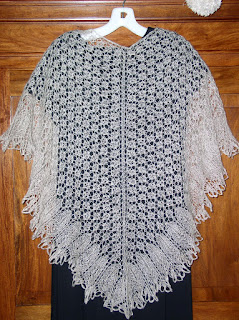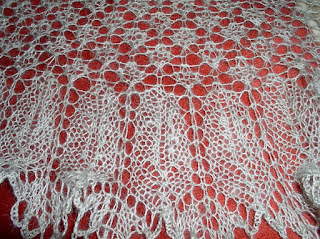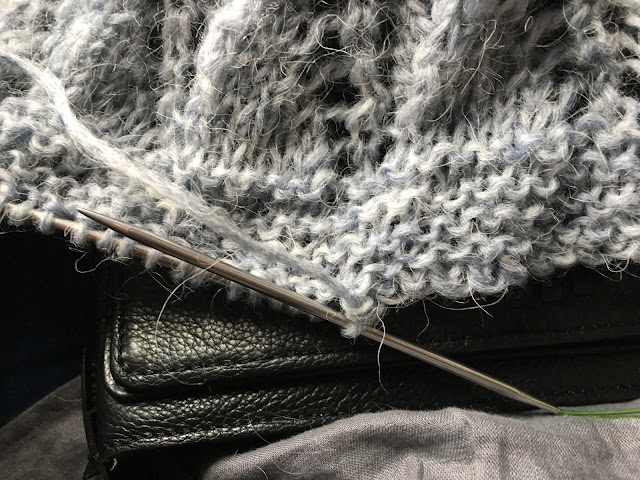Icelandic Shawl Halfskak
Here she is.
 The border increases quite rapidly. In twenty rows it almost doubles, twice, going from 300 stitches to nearly 1000.
The border increases quite rapidly. In twenty rows it almost doubles, twice, going from 300 stitches to nearly 1000.

Her body is composed of Spider stitch, which is very useful for shawls that drape nicely. A triangle results from 4 increases every 2 rows. Spider stitch lets you increase 4 sts in two rows, and 8 in the next two rows.
The extra increases spread the shawl out more rapidly, essentially, which produces more of a crescent shape at the front edge.

Here the shawl is blocking on my rug, and you can easily see the more-than-triangle shape.
A close up of the spider stitch, as well as the border.
 The border increases quite rapidly. In twenty rows it almost doubles, twice, going from 300 stitches to nearly 1000.
The border increases quite rapidly. In twenty rows it almost doubles, twice, going from 300 stitches to nearly 1000.This produces a bit of a ruffle-- which produces a blocking challenge! Normally, each loop of crochet chain gets stretched straight out at the bottom of the shawl.
You can't do that on this one-- there is not enough room laterally, due to the sheer number of stitches, and the scallop.
Here's a picture I took while I was pinning it out.  Each of those little points is bigger than the space available for stretching, because of the flare effect both in and around the scallops.
Each of those little points is bigger than the space available for stretching, because of the flare effect both in and around the scallops.
 Each of those little points is bigger than the space available for stretching, because of the flare effect both in and around the scallops.
Each of those little points is bigger than the space available for stretching, because of the flare effect both in and around the scallops.I wound up overlapping parts of each scallop and pinning them together, so as to stretch the border nicely. It looks like the bottom edge is even, but it's not: it is very scalloped. It just looks that way because of the way I pinned it.
It looks like the bottom edge is even, but it's not: it is very scalloped. It just looks that way because of the way I pinned it.
 It looks like the bottom edge is even, but it's not: it is very scalloped. It just looks that way because of the way I pinned it.
It looks like the bottom edge is even, but it's not: it is very scalloped. It just looks that way because of the way I pinned it.Here's the front:
 ... and the back.
... and the back.
 Sigridur Halldorsdottir says to just let the border flare out (unless that was Marilyn's addendum in her translation).
Sigridur Halldorsdottir says to just let the border flare out (unless that was Marilyn's addendum in her translation).

 ... and the back.
... and the back. Sigridur Halldorsdottir says to just let the border flare out (unless that was Marilyn's addendum in her translation).
Sigridur Halldorsdottir says to just let the border flare out (unless that was Marilyn's addendum in her translation). The original design has the border shade from the white body of the shawl through to a natural black at the very edge. Obviously I did not do this.
Specifics:
3.25mm ebony Holz and Stein circular needle
Lace weight Icelandic wool/mohair mix in a natural beige, from Tongue River Farm. (They have a very limited supply left from last year.) It is a very crisp yarn, which blocks out beautifully. Unblocked it looked (like much lace) like an unorganized lump. 8 ounces are 1700 yards; I have to guess how much I used, as my scale is packed up. About 550 yards, I'd say.
I have to say that while I was working on it I was very worried I would hate the hand of the resulting lace.
I was wrong. It is very lustrous and heavy-feeling, a bit like alpaca, yet holds its shape beautifully.
Pattern in Three Cornered and Long Shawls, by Sigridur Halldorsdottir. It's available in Icelandic with a translation of the instructions (only) to English, done by Marilyn Van Keppel. Available from Schoolhouse Press.
To celebrate, guess what I did this morning?




Comments
As for he Yubina cash/silk, the red I show is #222. It's my favorite color--a slightly dark, rich red. I found the colors to be mildly accurate if I pushed back the laptop display to make the colors a bit darker than shown on the site. When you order, request samples. They send about ten small samples, which are useful for calibrating your monitor.